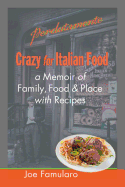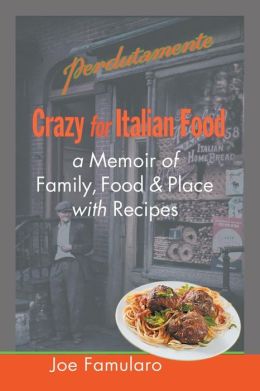 What is the name of the book and when was it published?
What is the name of the book and when was it published?
“CRAZY FOR ITALIAN FOOD (Perdutamente), a memoir of family, food and place, with recipes”, published June 12, 2013
What’s the book’s first line?
“Except for the youngest of us, seven of my eight brothers and sisters and I were born at home in our tenement on West Forty-Sixth Street”.
What’s the book about? Give us the “pitch”.
From start to finish, Famularo doesn’t simply supplement a cookbook with interesting stories or offer recipes here and there to satisfy a foodie craving; he carefully combines ingredients of family memories and deeply felt moments, folding in an equal measure of food culture and passion. The result is not gimmicky or disjointed, but a complete joy to experience.
The two elements are so perfectly married in unexpected ways. Through one complete generation of an immigrant Italian family living in New York City, Famularo looks at raising children alongside recipes for pasta and soup, explores the fears women had in the early twentieth century about pregnancy while describing the patient process of rising and shaping bread dough, and looks at old age and death through the eyes of a grandfather’s love for a fig tree growing on the fire escape.
Through thoughtful storytelling and honest writing, the author journeys into the heart of his childhood home, the kitchen, and welcomes the reader as a member of the family. An Italian cooking expert, Famularo does not disappoint with his recipes. His instructions for the classic staples of Italian-American fare—fluffy meatballs, chewy pizza, and comforting minestrone—are easy to follow and yield superb results. More unique creations like “Papa’s Immortal Quick Pasta” and “Mary’s Italian Cake” are no less impressive. The value of lifting the curtain on a family’s unique recipes, particularly when accompanied by the squabbles, the antics, and the unsung heroism of the Italian mama in her kitchen, is priceless.
What inspired you to write the book? A particular person? An event?
I was inspired to write this book after a long argument with friends about families who eat together and those who don’t. I always felt a family who eats together stays together. In my own family, not one brother or sister ever divorced. Even today, my one remaining sibling, my sister Louise, and I have Sunday lunch together as we all did in the old days. Her husband joins us for that is exactly what they did in his home. Compare this life-style with today’s broken homes, the number of children out-of-wedlock, number of children and family on public assistance; no one, repeat, no one in my book ever took a penny from government – what they had, they worked for, and this takes place during the great depression of the 1930s.
What’s the most distinctive thing about the main character? Who-real or fictional-would you say the character reminds you of?
The main character is the mother in the story who manages a large household on very little money but sees to it that healthy food, good and tasty food is on the table everyday.
She is a very strong woman and in her simple way, i.e. native intelligence and sense of cunning, she manages to keep a family together. Fictional characters who are like her might be the Jane Darwells of the 30s and 40s, pioneer women as in The Grapes of Wrath, or Sophia Loren in Two Women during World War II.
What’s the main reason someone should really read this book?
The real reason to read this book is to experience excellent fool-proof Italian recipes (they all have been cooked hundreds of times in this one family). Choose one or two recipes from a chapter, cook it, and then eat, reading the story in the chapter from which came the recipes. You will love it and have a ball. Since there are 26 chapters, you can be busy this way all year long. Remember, many of these recipes make excellent leftovers, and you will not have to worry about lunch or supper the next day.
